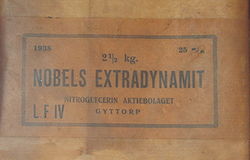Dynamite

Dynamite is an explosive invented by Alfred Nobel, the creator of the Nobel Prize. Its main explosive component is nitroglycerin. Nitroglycerin is very sensitive to movement. It explodes very easily when it is moved. For this reason, it is absorbed into diatomaceous earth to make it less sensitive. Diatomaceous earth is a soft, sedimentary rock made of fossil diatoms. About one-quarter of dynamite is diatomaceous earth, the other three-quarters are nitroglycerin. A little sodium carbonate is added to stabilize the mixture.
Even though the diatomaceous earth takes away some of the dangers of nitroglycerin, there are still problems because the mixture is not stable in damp environments. Water causes the nitroglycerin to leak away. The nitroglycerin can build up, and explode unexpectedly.
For this reason, the formulation was changed. Instead of diatomaceous earth, gelignite was used to hold the nitroglycerin. Gelignite holds the nitroglycerin so that it cannot dissolve in water.
Today, dynamite is not much used. It has been replaced by explosives based on ammonium nitrate which use gelignite. These explosives cost less to make and are easier to handle than dynamite. However, works of fiction still show people using dynamite.


